Forum Replies Created
-
AuthorPosts
-
 Bill WardParticipant
Bill WardParticipantHI,
Sounds great! The lines I’ve got from the NIST site indicate the Cobalt and Nickel lines are just out of reach in the UV for my system.
Titanium and Vanadium have been reported in meteor spectra but I’ve never conclusively ID’d those elements. It might be possible now I’ve got to this level of resolution and sensitivity!
Cheers,
Bill.
 Bill WardParticipant
Bill WardParticipantDear oh Dear, just as well I said “some” certainty….!
I’ve been studying the original image very closely and what I thought might have been faint second order lines appear to be in fact some of the very lines I thought were not present. There is the faintest hint of the 777.4nm O line. So it was “probably” traveling at a lowish Vg!
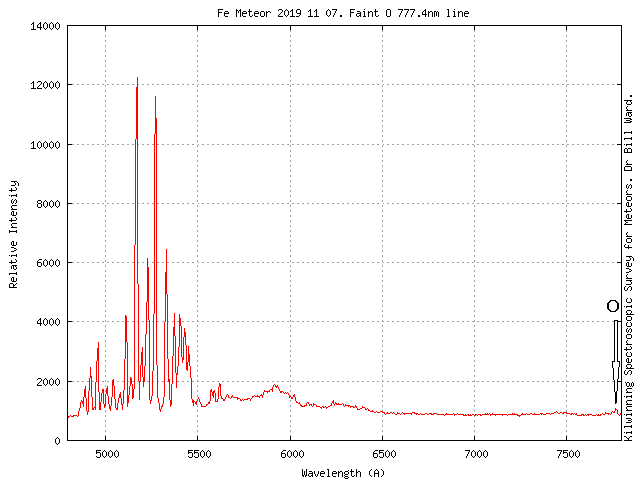
Always be skeptical, LOL!
 Bill WardParticipant
Bill WardParticipantCould be, LOL!
 Bill WardParticipant
Bill WardParticipantI’m giving myself a headache!!!
By trying to figure out what it can’t be (in terms of “normal” meteor lines) I’m down to around 150 lines from and handful of metal elements (non Fe neutral and ions) plus around 100 main Fe lines.
Still seems kinda uphill… ; – )
 Bill WardParticipant
Bill WardParticipantHi,
I Initially thought the line to the right were a second order also but I’m not sure. Careful examination reveals the separations don’t quite tie up with twice the wavelength even correcting for the slight non linearity of the dispersion.
Checking through the NIST data base there are over 2000 Fe lines listed from 350-450nm. Looking at the “stronger” ones I still can’t get a clean fit.
I’m sure I’m imposing am image scale bias, as this one is very large for a meteor spectrum. 35mm focal length is positively a telephoto lens in the meteor observing world.
I’ve chopped the spectrum into shorter sections from a single 45ms slice (it looks quite different when examined this way, a curious psychological effect.)
It may or may not help….! ; – )
 Bill WardParticipant
Bill WardParticipantYep, that’s correct. near UV towards left hand side and the whole thing is an emission spectrum.
Based on the sensitivity profile from other spectra, the wavelength span is around 360-650nm (ish!)
Continual failure with the usual elements in meteors is making me more convinced it is some sort of man made “stuff” re-entering.
No luck with an orbit so far, as that would at least help resolve the natural/man made issue.
However, if it is an artificial source there are not that many spectra of what’s coming back in so it’s still interesting in it’s own right!
 Bill WardParticipant
Bill WardParticipantHi,
Yes, I’ve tried all of these approaches and I still don’t get anything I can make sense of. Checking against several cometary spectra was the first port of call since it doesn’t match any meteor spectrum I’ve caught. In the 11 years I’ve been actively pursuing the video operations I’ve had one other like this. That has just been put in the “unknown” category.
I’ve got a few more strategy’s to apply first. I’ll figure it out eventually… maybe! ; – )
Cheers,
Bill.
 Bill WardParticipant
Bill WardParticipantIndeed, LOL!!! ; – ))
Been leafing through my optoelectronic texts. The cut of a si photodiode can be as low as 320nm but the glass will probably attenuate that heavily. I’m thinking the shortest wavelength have got to be of the order of 350nm.
I think I can see some pattern of Fe lines at the extreme left BUT if that’s correct then there is nothing at the usual Ca wavelength. So it would need to be a pure Fe/Ni. Problem with that is I have never seen such diffuse bands before. This is usually the sign of multiple electronic bands overlapping from molecules.
Something to do on the weekend if it’s raining I suppose….
cheers,
Bill.
 Bill WardParticipant
Bill WardParticipantMmm, having tried a few comparisons and matching existing spectra I have no clue as to what this thing is!
I found some spectra of the Hyubusa 1 probe re-entry which actually had some similarities but were of much lower resolution.
Rather re-enforces my suspicion it might be space debris. However an allsky shot has been secured of what might be the same object. A nice bright greenish coloured fireball. So I’d wager most of these lines will be iron or magnesium, magnesium alloy’s are probably common in space frames I’d imagine.
Next plan is just a slog to try and match up library lines….
Cheers,
Bill.
20 September 2019 at 10:09 am in reply to: Talk about Irish Astronomer: John Birmingham (1816–1884) #581383 Bill WardParticipant
Bill WardParticipantInteresting watch.
Thanks for posting it Ronan.
The comment in the presentation that there were over 1000 people attending the BA meetings got me thinking. There were probably a lot more “gentlemen astronomers” from this era, viz Mr Birmingham, than maybe we realise!
The list of big scopes is revealing, “the biggest refractor in the world at the time”! How many amateurs can make a claim like that today!? ; – ))
Like Mr Birminghams’ work, all of this great effort has more than likely been lost forever, which is rather sad.
I really like the quote at the bottom of the last image, “… to excite simple admiration rather than scientific reflections”.
A wonderful reminder that we all need to take a step back from time to time.
 Bill WardParticipant
Bill WardParticipantAs I don’t have her direct contact details I’d just like to let Ann D. (on the sales desk) know that the observing guide arrived safely.
Thanks!
Bill.
 Bill WardParticipant
Bill WardParticipantIndeed it was an excellent weekend! I was particularly delighted to meet up with the Armagh Observatory director Prof Michael Burton. Michael was my supervisor when I got my first student job at the Anglo Australian Observatory in 1991.
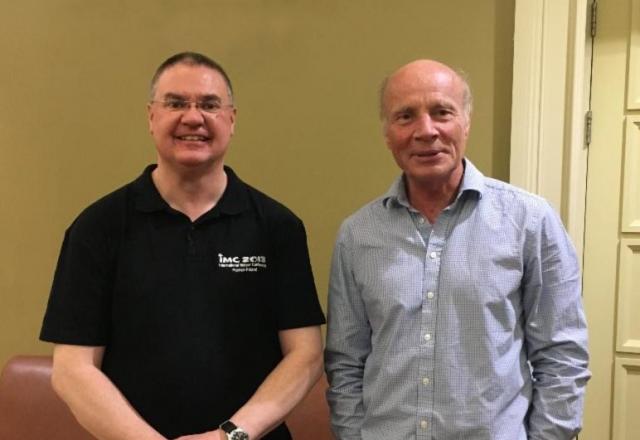
Where does the time go….!?
As you say, the evening sessions were most entertaining. I have no doubt that this is where the real meeting actually happens ; – ))
I’m looking forward to the next one….
cheers,
Bill.
 Bill WardParticipant
Bill WardParticipantHi,
With running out of the stuff myself I had a look around the net at the various suppliers. Not that it makes much practical difference but it appears the film grating is sold as 1000 lines/mm (25400 lines/inch) or 500 lines/mm (12700 lines/inch).
I also found a supplier of 532 lines/mm crossed grating material which is an interesting product. In theory that should produce a useable spectrum no matter what angle the meteor fall across the FOV. However there is a BIG penalty in magnitude as the light per spectrum would now be divided into 8 spectra, four at right angles to each other and 4 fainter at 45 degrees. It’s probably more of a novelty laser pointer effect filter but….
I can feel some olde fashioned optical experiments coming along….
cheers,
Bill.
 Bill WardParticipant
Bill WardParticipantHi,
Done some more work on the spectrum and the lines in the trail are coming out with a FWHM of around 1nm and the measured dispersion is 0.46nm/pix. It’s now just about where I want to be. It’s seeing how all the little lines behave that tells the story…
Cheers,
Bill.
 Bill WardParticipant
Bill WardParticipantHi,
Thanks Jack.
It gets better….!
Whilst concentrating on the flare as it had so many lines I didn’t really pay attention to the bright pair that ran close to the bottom of the image and through the camera ID text.
Taking a closer look revealed something remarkable. Since I started regular meteor spectroscopy around 2007 I’ve had the rather arbitrary goal of getting to a system that would resolve the bright green Mg triplet ~517nm. It’s tough to do completely!
When I chopped up the image and fitted the lines, it turns out that the “pair” is actually a partial resolution of the triplet! The 516.73nm and 517.27nm are just too close for this lens/grating/seeing combo but at the 1nm FWHM and 0.46nm/pix level it is just enough to see the 518.36nm line as separate, just over 1nm (2 pixels) between them. Here’s a plot with the brighter lines identified.
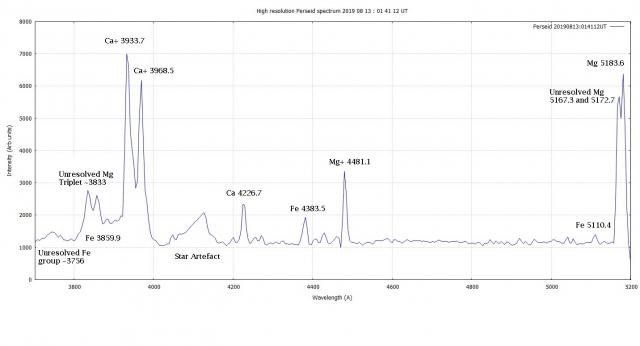
Well pleased with that!
Cheers,
Bill.
 Bill WardParticipant
Bill WardParticipantah ha, I knew I had a picture of the triplet some where….
The power of spectroscopy, the same elements but on the sun (in absorption, not in emission as in a meteor spectrum!) I took this with a home made solar spectroscope, donkey’s years ago, it shows the main Mg lines plus a ton of Fe, Cr and Ti lines. These’ll be hiding in the meteor spectrum too!
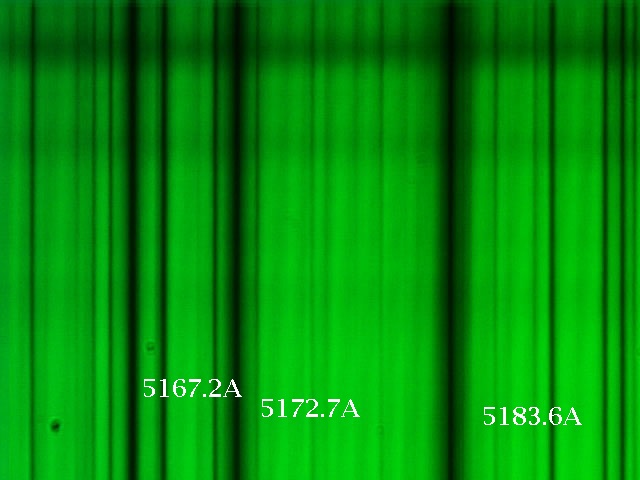
Cheers,
Bill.
 Bill WardParticipant
Bill WardParticipantHi,
The set up has always been, more or less…, the same. Stick a grating in front of your lens and see how it goes!
The plastic grating film now seems to be sold all over the place. The stuff I currently use I bought from Edmond Optics in 2009, £6.99 plus shipping etc. This was the second batch. The first was from the early 90’s. Trying searching for “holographic plastic grating film” or similar combination. Again, the stuff I bought, of US origin was sold in 12 inch x 6 inch sheets with either 12500 or 25000 lines per inch. I use the 12500 version which is just under 500 lines/mm.
It’s on Amazon and ebay as effect filter, novelty pattern filter, rainbow generator etc etc. You can even buy a 200 foot roll if you want to!
I should caution that TWO results (this and one other spoardic of almost the same magnitude) might not represent a statistically significant sample but with a bright enough meteor the plastic film seems to have a better throughput at the blue end of the spectrum than my much more costly glass gratings. Given the spec of the glass gratings this seriously surprises me! So I have now come to the conclusion that it’s a much more cost effective way to start should anyone wish to give meteor spectroscopy a go. I think this is pretty much old hat now as lots of stuff is online about it. I gave up on it when I ultimately stopped trying film based photographic spectroscopy which yielded precisely zero over 15 years prior to me using video. I decided to try it out again for financial reasons.
Due to the embossing process the grating is not blazed so equal amounts of light go into the spectrum on each side and because it’s a simple sinusoidal embossing the spectral throughput, overall, is less than a good glass replica. The upshot is you need brighter meteors to produce a spectrum all else being equal. Effectively you get half the light in your spectrum but at 1/20 the cost of a proper grating. It’s up to the prospective observer to decide whether that’s a reasonable cost/benefit analysis.
I used to have quite a bit of the stuff as I bought several sheets at the time but I have given it all away in little bits and pieces to those who wanted some to experiment with. At seven quid, cheaper from ebay, I don’t know if it’s exactly the same stuff though, it’s not going to break the bank.
Bit of a ramble but I hope it helps….
Bill.
 Bill WardParticipant
Bill WardParticipantExactly!, whilst I tried to resist I couldn’t help it given the subject…
Without being overly crude, in youthspeak… I LMFAO ; – ))
 Bill WardParticipant
Bill WardParticipantHi,
Phaeton (3200) is indeed interesting. After reading a paper by Rendtel and Ryabova (I’ll dig up the full reference….) which mentioned that we might encounter very recently emitted particles during the Geminids in 2017, I hoped to pick up some significant differences in their spectra. Particularly an excess of sodium. But despite catching 7 good spectra nothing seemed out of the ordinary.
I’m looking forward to what Destiny will reveal….
cheers,
Bill.
 Bill WardParticipant
Bill WardParticipantYour wish is my command… 😉
First is across the third “chop” back from the terminal flare.
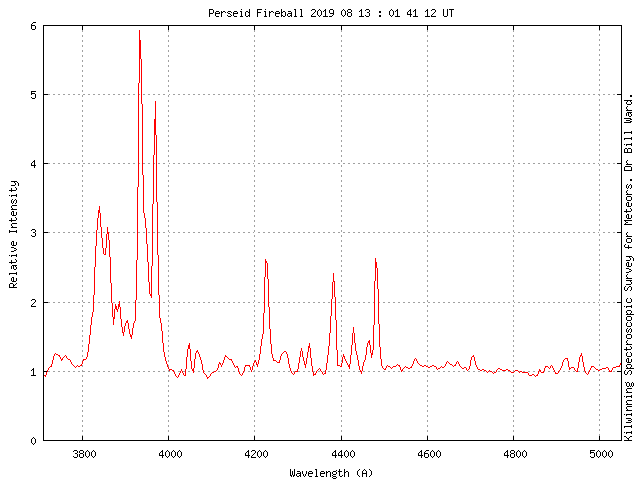
Second is across the terminal flare. Ca+ saturated but lot’s of metal lines light up. At least 35 lines (maybe a couple more) including the usual Mg, Ca and Fe but also Cr and Mn as well as possibly Ni.
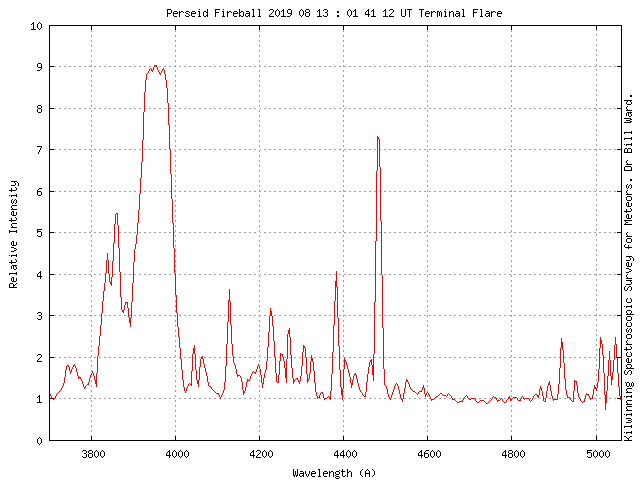
Despite it’s low efficiency, due to it’s embossed profile, I’m really surprised (and pleased) with the performance of the plastic film. I’m becoming convinced that it does have slightly better properties in the UV/Blue compared to the expensive glass gratings.The results are evidence enough I think…
R is around 1000, not bad for such a basic transmission set up.
Going to leave a couple of glass ones on but change the rest to plastic and see how it goes over the next season.
The weather gods certainly gave me a break last night but I think we’re in for more heavy showers tonight….
Cheers,
Bill.
-
AuthorPosts
